On this Day in History ... 23rd May
23 May is in May.
1162 Thomas Becket appointed Archbishop of Canterbury
1430 Capture of Joan of Arc at the Siege of Compiègne
1455 First Battle of St Albans
1460 June Yorkist Landing at Sandwich
1467 Tournament Bastard of Burgundy
1533 Cranmer declares Henry and Catherine's Marriage Invalid
1533 Marriage of Henry VIII and Anne Boleyn
1536 Trial of Anne and George Boleyn
1550 Visit of the French Ambassadors
1557 Creation of Garter Knights
1587 Execution of Mary Queen of Scots
1661 Creation of Baronets and Peerages by Charles II Post Coronation
Events on the 23rd May
On 23 May 1052 Philip "Amorous" I King France was born to King Henry I of France (age 44) and Anne Rurik Queen Consort France (age 22).
John of Worcester. 23 May 1070. On Whitsunday [3rd May] the king (age 42), at Windsor, Berkshire [Map], gave the archbishopric of York to the venerable Thomas, canon of Bayeux, and the bishopric of Winchester to his chaplain, Walkeline. On the following day, by the king's command, Ermenfrid, bishop of Sion, held a synod, [the other legates] the cardinals John and Peter having returned to Rome. At this synod, Ethelric, bishop of Sussex, was uncanonically deposed; and although he was guilty of no crime, the king soon afterwards placed him in confinement at Marlborough, Wiltshire [Map]; several abbots were also deprived. After these depositions, the king gave the bishopric of East-Anglia to Arfast, and the bishopric of Sussex to Stigand79, who were both his chaplains; which Stigand transferred his see to Chichester, the chief city in his diocese: the king also gave abbeys to some Norman monks. The archbishop of Canterbury being degraded, and the archbishop of York dead, Walkeline was, by the king's command, consecrated by the same Ermenfrid, bishop of Sion, on the octave of Whitsunday [30th May].
Note 79. This first bishop of Chichester must not be confounded with the archbishop of the same name.
On 23 May 1107 Louis "Fat" VI King France (age 25) and Lucienne Rochefort (age 19) were divorced.
Florence of Worcester Continuation. 23 May 1125. The emperor Henry (age 43) died, and was buried at Spires, where his grandfather was also interred. Lothaire, the ninety-eighth emperor of the Romans, reigned thirteen years.
On 23 May 1162 Archbishop Thomas Becket (age 42) was elected Archibishop Canterbury by King Henry "Curtmantle" II of England (age 29).
23 May 1200 Louis "Lion" VIII King France (age 12) and Blanche Ivrea Queen Consort France (age 12) were married. She the daughter of Alfonso VIII King Castile (age 44) and Eleanor Plantagenet Queen Consort Castile (age 38). He the son of King Philip II of France (age 34) and Isabelle Flanders Queen Consort France. They were third cousins. He a great x 3 grandson of King William "Conqueror" I of England. She a granddaughter of King Henry "Curtmantle" II of England. 


After 23 May 1373. St Chad's Church, Longford [Map]. Monument to Nicholas II Longford (deceased). Camail and Jupon Period.
Nicholas II Longford: Around 1334 he was born to Nicholas Longford and Alice Boteler at Longford. On 03 Apr 1347 Nicholas II Longford and Alice Deincourt were married. He a great x 5 grandson of King Henry "Curtmantle" II of England. On 23 May 1373 Nicholas II Longford died at Longford.
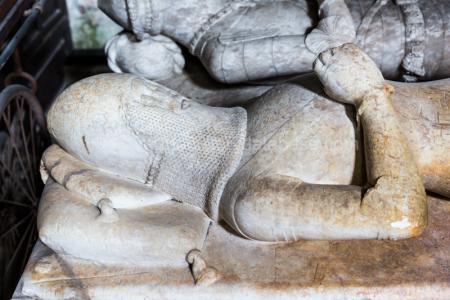
On 23 May 1390, St George's Day, a Jousting Tournament was held at London Bridge [Map]. David Lindsay 1st Earl Crawford (age 30) so easily unhorsed the King's Champion John Welles 5th Baron Welles (age 38) as to make the crowd suspect Lindsay of foul play by fastening himself to his saddle. To prove the crowd wrong David Lindsay 1st Earl Crawford (age 30) leapt from his horse in full armour, then back again. Realising John Welles 5th Baron Welles (age 38) was injured he rushed to his aid. He visited Welles every day until he recovered. The two became firm friends.
On 23 May 1430 Joan of Arc (age 18) was captured during the Siege of Compiègne. John Luxemburg II Count Ligny (age 38) commanded the rear-guard. Philip "Good" Valois III Duke Burgundy (age 33) fought.

Archaeologia Volume 20 Section VIII. An Account of the First Battle of St. Albans from a contemporary Manuscript. Communicated by Joun Baytey, Esq. F.S. A. of His Majesty's Record Office in the Tower; in a Letter to Henry Extis, Esq. F. R. S. Secretary.
Read 19th December 1822.
His Majesty's Record Office, December 12, 1822.
DEAR SIR,
I inclose a curious Account of the first Battle of St. Albans, which may prove interesting to the Society of Antiquaries: it is copied from a manuscript, in a co-eval hand, found in the Tower, among a large quantity of private letters and accompts of Sir William Stonor, Knt [William Stonor (age 5)?] who, from his correspondence, appears at that time to have been much about the Court, and was also a Steward of the Abbot of St. Albans. The original is written in a book consisting of a few leaves of a small quarto size, and, on comparing the writing with some of the other papers, it seems to be in the hand of Sir William himself.
I remain, dear Sir, your's very faithfully,
JOHN BAYLEY.
To Henry Ex is, Esq &c. &c. &c.
Calendars. Membrane 13d. 23 May 1460. Commission to Osbert Mountford and John Baker, esquires, ordered, Coventry, by advice of the council, to bring 200 men at arms and archers to Henry, duke of Somerset (age 24), for the safe keeping and defence of the castle and town of Guysnes and to resist the king's rebels and enemies, appointing them to arrest ships and vessels necessary herein and masters and mariners therefor.
Commission to Thomas Thorp, Thomas Kiriell (age 64), knight, John Cheyne, knight, Thomas Broun, knight, Henry Lowes, esquire, John Scot and Robert Home, to take the muster of the said Osbert Mountfort and John Baker and the said men at arms, and to certify the king thereof in Chancery.
On 23 May 1467 Antoine "Bastard of Burgundy" (age 46) arrived at Greenwich, Kent [Map] with a retinue of 400 people to take part in a great Tournament. He was greeted by John "Butcher of England" Tiptoft 1st Earl of Worcester (age 40).

Letters and Papers 1533. 23 May [1533]. R. O. St. P. I. 396. Cranmer's Letters, 243. 528. Cranmer to Henry VIII.
Today, 23 May, I have given sentence in your great and weighty cause. I send a copy thereof by the bearer, Ric. Watkyns. As I was advertised by the letters of Mr. Thurlesbye, your chaplain, that it was your pleasure that I should cause your counsel to conceive a procuracy concerning the second marriage, I have sent the letters to them, and required them to act accordingly. I desire to know your pleasure concerning the second matrimony as soon as you and your counsel are perfectly resolved therein, for the time of the coronation is so near at hand that the matter requires good expedition. Dunstaple, 23 May. Signed.
P. 1. Add. Endd.
Letters and Papers 1533. 23 May [1533]. R. O. 526. Thomas Bedyll to Cromwell.
Sentence of divorce was given this day, 23 May, at 10 a.m., in open court, without contradiction. I have written this that you may signify it to the King if you be at court, that the King may have knowledge of it to his satisfaction. This day was appointed for the sentence at the last court. The King's commands, written to the Archbishop by Thirleby, were declared to my company here and to me, and we have done as much as the shortness of the time will allow. My servant comes post, having new horses at St. Alban's and Barnet. Dunstable, 23 May, after 10 o'clock a.m.
Hol., p. 1. Add. : Of the Council.
Letters and Papers 1533. 23 May [1533]. R. O. 525. John Tregonwell to Cromwell.
My lord of Canterbury (age 43) gave sentence this day at 11 o'clock in the great cause of matrimony ; has declared it to be against the law of God, and has divorced the King from the noble lady Katharine. He has used himself in this matter very honorably, and all who have been sent hither on the King's behalf have acted diligently and towardly. Sentence shall be given for the King's second contract of matrimony before the Feast of Pentecost. The process is partly devised. 23 May.
Hol., p. 1. Add. : Of the Council. Endd.
Letters and Papers 1533. [23 May 1533]. R. O. Rym. XIV. 462. 529. The Divorce.
Notification of the sentence1 of divorce between Hen. VIII. and Katharine of Arragon pronounced by archbishop Cranmer. Dated in the monastery of Dunstable, 23 May 1533. Present, Gervase prior of the said monastery, Simon Haynes, S.T.P., John Newman, M.A., and others.
Two copies ; one badly and the other slightly mutilated.
Note 2. The sentence itself, as recited in the patent of 6 June (see Grants in June 1533, No. 7.), is printed both in Burnet and in Wilkins.
On 23 May 1533 Thomas Cranmer Archbishop of Canterbury (age 43) declared the marriage of Henry VIII (age 41) and Catherine of Aragon (age 47) invalid. 

Letters and Papers 1533. 23 May 1533 Lanz, II. 66. 523. Charles V. to Ferdinand of Hungary.
I wrote on the 12th what I had learned about the marriage (l'esposement) of the king of England to Anne Boleyn (age 32). I have since received letters from my ambassador, by which you will see that the said marriage is accomplished, and that the King holds her as his wife and queen of England. Although the injury done to the Queen and Princess is extreme, and there is little hope of bringing Henry to reason, considering the delays and subterfuges used by him and the Pope, yet after careful consideration it has been thought best to persist in the demand for justice, as you will see by the copy of our despatches to Rome and England; and that you also should send some one to Rome to urge the matter. I write also to the king of Portugal to do the like. Barcelona, 23 May 1533. Fr.
Letters 1536. 23 May 1536. Add. MS. 28,588, f. 276. B. M. 947. Dr. Ortiz to the Empress.
Received today her letter of 15 April. Supposes that the Empress has since received his letters with news of the Princess's health. No letters have arrived from Eustace Chapuis, but the queen of Hungary writes that the king of England has imprisoned his mistress (deceased) in the Tower. Other letters state that in order to have a son who might be attributed to the King, she committed adultery with a singer (deceased) who taught her to play on instruments. Others say it was with her brother (deceased). The King has sent them to the Tower with her father, mother, and other relations. Expresses his joy at her fall, which will ensure the safety of the Princess.
Remembers that the cardinal of Burgos told him he had heard, when ambassador in England, that it was foretold that this Ana would be burnt to death.
It is said that the king has taken from "Maestro Cronvel" the office by which he did so much harm to the monasteries; and that he has chosen two Catholic bishops of good life, by whom he wishes to be governed.
The bull for the convocation of the Council has been concluded by the Consistory, and will be intimated soon. The Pope has given up his journey to Bologna. The card. of Santa Cruz is going to Hungary to negotiate between the king of the Romans and the Vayvode. Rome, 23 May 1536.
Sp., pp. 3. Modern copy.
Letters 1536. 24 May 1536. Add. MS. 8,715, f. 252. B. M. 956. Bishop of Faenza (age 36) to Mons. Ambrogio.
According to information from England, received by the King yesterday, on the 15th inst. the Queen (deceased) was degraded, and the following day was to be executed,—either burnt or beheaded; but first her brother (deceased), four gentlemen, and an organist (deceased), with whom she had misconducted herself, were to be quartered in her presence. It is not true that her father (age 59) and mother were imprisoned, but the former (age 59), being on the Council, was present at his daughter's (deceased) sentence. All was done in the presence of the French ambassador only. It is said that the King has been in danger of being poisoned by that lady (deceased) for a whole year, and that her daughter (age 2) is supposititious, being the child of a countryman (villano); but these particulars are not known for certain, according to what the King said today. The discovery was owing to words spoken by the organist (deceased) from jealousy of others. They are expecting now the declaration of the true daughter to reinstate her and annul what was done in favor of the other. Has not omitted to show what may be done on this occasion for the honor of God, &c. The French king answered that he ardently desired to bring back Henry to the Church, and that he would not fail in endeavouring to do so. He knows that the Imperialists have offered the king of England the queen of Hungary as a wife, but it is thought he will not take her, as she is in bad health, and not fit to bear children. He has today sent a person to his Ambassador about these affairs. He thinks it would be easy to bring back the King if it were not for his avarice, which is increased by the profit he draws from Church goods. The English ambassadors here are in very great joy. Knowing that one of them was a good man, and a friend of his, caused the opportunity and advantage of the King's coming back to the Pope to be shown to him; and that he should be neutral, and give the Emperor and (French) king to understand that he would oppose whoever refused peace; that there was not a better opportunity of wiping out the stains on his character, and making himself the most glorious King in the world; that every one should do his duty, and they would find in the Pope that true piety and goodness which ought now to be known to all the world. The Ambassador, and Winchester also, who is the other, thanked him, saying, with many tears, that this was their only desire, and they would do their part, so that they hoped we should soon embrace each other.

Ital., modern copy, pp. 6. Headed: Al Signor Protonotario Ambrogio, Da Lione, li 24 Maggio 1536.
Diary of Edward VI. 23 May 1550. Mon. Chastil(lon) (age 31) and Mortier, and Bouchetel, accompanied with the Ringrave (age 46)1, Dandelot2, the constable's secound sone3, and Chenault the ligier4, cam to Durasme place, where in their journei thei wer met by mr. tresoror (Oheyne) and threscore gentlemen5 at Whulwhich [Map], and also saluted with great peales both at Whulwich, Dettford [Map], and the Towre [Map].1a
Note 1. The Rhinegrave John Frederick (age 46) was deprived of his electorate by the emperor after the battle of Muhlberg in 1547, and remained a prisoner at Innspruck until 1552. His nephew Otho-Henry, called the Magnanimous, whose proper title was only count of Neuburg until after his uncle's death in 1556, was at this time in the service of France, and was made a knight of St. Michael in Oct. 1550 (see Tytler, i. 325).
Note 2. The seigneur d'Andelot was François de Coligny (age 29), younger brother of the seigneur de Chastillon (age 31), already noticed in p. 250, and like him a zealous Calvinist and intrepid soldier. He became comte of Laval and Montfort in Britany; and in 1555 he was appointed colonel-general of the French infantry in place of his brother. He died in 1569. (Anselme, vii. 155; viii. 215.)
Note 3. The second son of the constable of France was Henry (age 15) afterwards duc de Montmorency, who now, during his father's (age 57) lifetime, bore the title of seigneur de Damville. (Anselme, Histoire Genealogique, vi. 229.) If the King writes with accuracy, he must have been one of the train; but if he meant one and the same person by "Dandelot, the constable's second sone," this may have arisen from d'Andelot being (by his mother's side) "the constable's nephew, and one of the (French) king's minions." (Tytler, i. 160.)
Note 4. Of Chenault no particulars have occurred. Among the illustrious visitors on this "occasion, or immediately after, appears to have been Claude de Lorraine, due d'Aumale, third son of the late due de Guise. On the 6th Oct. following sir John Mason (age 47) writes from Rouen to the council: "The due d'Aumale is much desirous to have a portrait of the King's person, which he says the King himself promised him at his departing out of England. He hath been in hand with me twice or thrice herein, praying me in my next despatch to desire your lordships to put his Majesty in remembrance hereof. If any shall be sent unto him, this is a very good time therefor, while yet he remaineth in Roan. He speaketh very much honour of the King and of the realm, and hideth not the courtesy he found the time of his being there. He is, as your lordships knoweth, of right good estimation, and therefore the remembring of him in this his request cannot be but well bestowed." (Tytler, i. 330.)
Note 5. In order that the court might make a good show of nobility when the Frenchmen arrived, the council had despatched, on the 17th of April, "Lettres severall to the earles of Rutland (age 23), Bathe (age 51), and Worcester (age 24), to the viscount Hereford (age 62), and the lord Fitzwalter, to repayre to the court out of hand, bringing with them their best apparell and furniture, for the receiving and entertaining of the ambassadors and noble men that came out of France."
On the 4th May, "For the receaving of mounsr Chastillion, and the rest of the Frenche ambassadors, the lord warden of the Cinque portes, thresorer of the King's Majesties household, was appointed to be the chief, and a nombre of lords and gentlemen apoincted to accompanie him by water with the King's barges, bicause th'ambassadors are determined to come from Bulloigne in their owne galleys up alongest the Teames [River Thames]."
"May xviij. A warrant to the master of the jewelhouse to deliver unto Benjamin Gonstone, threasorer of the King's shippes, one peir of potts, one peir of flagons, iij. nest of bolles, ij. basons and ewers, a garnish and a half of vessell, ij. dozen of plates, and ij. saltes of silver, for the furniture of the galley appointed for the lord wardeigne to mete the French ambassadors coming up by the Temes [Thames], to be restored again upon retorne of the same galley. A warrant to sir John Williams to delyver to the said John Gonstone xlli. in prest towards the furniture of the said galey." (Council Book.)
Note 1a. "On Friday was seven-night [May 23] the galley Subtle, with two other of the King's pinnaces, under the charge of sir William Woodhouse, mr. Brook, and others, were sent to the Thames mouth to meet with the French galleys, and to conduct them upwards, and at their first meeting received them with an honest banquet; so accompanied them along the Thames, where, passing by sundry of the King's ships, they were saluted by honest peals of ordnance; and, a little above Greenwich, I, the lord warden of the Cinque Ports (Cheyne), being accompanied with the earl of Worcester (age 24), the lord Grey of Wilton (age 41), the lord William Howard, with divers other young lords and gentlemen, to the number of sixty, in sundry barges, met with them upon the water, bade them welcome on the King's maties behalf, with other good words to the purpose, and so received them into those barges. They were conveyed by water through the bridge to their lodging, being appointed at Durham-place, which was furnished with hangings of the King's for the nonce: where, against their coming, was ready laid in a very large present of beer, wine, beeves, muttons, wild fowls, poultry, fish, and wax. By the way the King's ships at Deptford shot off; and at the Tower, as they passed, a great peal of ordnance was discharged to welcome them. As soon as they were landed, and in their lodgings, a gentleman was sent from the King's matie, willing me the lord warden, in the King's highness' behalf, to bid them welcome, and tell them that if they would aught, being signified, it should be provided; and so for that night left them." (Narrative of the council addressed to sir John Mason, the ambassador lieger in France, printed from Mason's letter-book in the State Paper office, by Tytler, i. 284.;
Henry Machyn's Diary. 23 May 1557. The sam after-non was chossen iij knyghtes of the garter, my lord Fuwwater depute of Yrland (age 32), my lord Gray (age 48) depute of Gynes, and ser Robart Rochaster (age 63) comtroller of the quen('s) howsse the iij. And after cam the duwcke of Muskovea cam thrugh the halle, and the gard stod in a-ray in ther ryche cottes with halbardes, and so up to the quen('s) chambur, and dyvers althermen and marchandes; and after cam downe a-gayne to the chapell to evyngsong, and contenent cam the Kyng (age 30) and the knyghtes of the garter to evyngsong; and when that evyngsong was down cam the Kyng and the knyghtes up to the chambur of presens; and after cam the duke of Muskovea, and toke ys barge to London, and that tyme my lord Strange bare the sword to evyngsong.

The Letter Books of Amias Paulet Keeper of Mary Queen of Scots Published 1874 Marys Execution. Poulet (age 54), as has already been said, was made Chancellor of the Garter in April, 1587, but he did not retain this preferment for a whole year. He continued in the Captaincy of Jersey up to his death, but he appears to have resided in and near London. In the British Museum are two letters from him of small importance. One, addressed to the Lord High Admiral, is dated, "From my poor lodging in Fleet Street [Map], the 14th of January, 1587," about "right of tenths in Jersey, belonging to the Government." The other, "From my little lodge at Twickenham, the 24th of April, 1588," "on behalf of Berry," whose divorce was referred by the Justices of the Common Pleas to four Doctors of the Civil Law, of whom Mr. Doctor Caesar, Judge of the Admiralty, to whom the letter was written, was one.
His name also occurs in a letter, from Walsingham to Burghley, dated May 23, 1587, while Elizabeth still kept up the farce of Burghley's disgrace for despatching Mary Stuart's death-warrant. "Touching the Chancellorship of the Duchy, she told Sir Amias Poulet that in respect of her promise made unto me, she would not dispose of it otherwise. But yet hath he no power to deliver the seals unto me, though for that purpose the Attorney is commanded to attend him, who I suppose will be dismissed hence this day without any resolution." And on the 4th of January following, together with the other lords of the Council, he signed a letter addressed by the Privy Council to the Lord Admiral and to Lord Buckhurst, the Lieutenants of Sussex, against such Catholics as "most obstinately have refused to come to the church to prayers and divine service," requiring them to "cause the most obstinate and noted persons to be committed to such prisons as are fittest for their safe keeping: the rest that are of value, and not so obstinate, are to be referred to the custody of some -ecclesiastical persons and other gentlemen well affected, to remain at the charges of the recusant, to be restrained in such sort as they may be forthcoming, and kept from intelligence with one another." On the 26th of September, in the year in which this letter was written, 1588, Sir Amias Poulet died.
Poulet was buried in St. Martin-in-the-Fields, London. [Map]. When that church was pulled down to be rebuilt, his remains, with the handsome monument erected over them, were removed to the parish church of Hinton St. George. After various panegyrics in Latin, French, and English inscribed on his monument, a quatrain, expressive apparently of royal favour, pays the following tribute to the service rendered by him to the State as Keeper of the Queen of Scots: Never shall cease to spread wise Poulet's fame; These will speak, and men shall blush for shame: Without offence to speak what I do know, Great is the debt England to him doth owe.Execution of Mary Queen of Scots.
On 23 May 1617 Elias Ashmole was born in Breadmarket Street Lichfield, Staffordshire [Map].
On 23 May 1644 Alice Leigh 1st Duchess Dudley (age 66) was created 1st Duke Dudley by King Charles I of England, Scotland and Ireland (age 43) for life. Her husband Robert Dudley (age 69) had claimed to be the legitimate son of Robert Dudley 1st Earl of Leicester but the Star Chamber found against him. King Charles I of England, Scotland and Ireland (age 43) disagreed with their verdict and, in compensation of her subsequent treatment, awarded her the Dukedom ...

And whereas, our father not knowing the truth of the lawful birth of the said Sir Robert (as we piously believe) granted away the titles of the said earldom to others ... and holding ourselves in honour and conscience obliged to make reparation; and also the said great estate which the Lady Alice had in Kenilworth, and sold at our desire to us at a very great undericon... we do... give and grant unto the said Lady Alice Dudley the title of Duchess of Dudley for life.
10 May 1661 William Smyth 1st Baronet (age 45) was created 1st Baronet Smyth of Redcliff in Buckinghamshire.
18 May 1661 Robert Jenkinson 1st Baronet (age 40) was created 1st Baronet Jenkinson of Walcot in Oxfordshire and of Hawkesbury in Gloucestershire.
20 May 1661 William Glynne 1st Baronet (age 23) was created 1st Baronet Glynne of Bicester aka Bisseter in Oxfordshire.
23 May 1661 Henry Ingram 1st Viscount Irvine (age 21) was created 1st Viscount Irvine.
Pepy's Diary. 23 May 1661. From thence home by water, and there shifted myself into my black silk suit (the first day I have put it on this year), and so to my Lord Mayor's by coach, with a great deal of honourable company, and great entertainment. At table I had very good discourse with Mr. Ashmole (age 44), wherein he did assure me that frogs and many insects do often fall from the sky, ready formed. Dr. Bates's singularity in not rising up nor drinking the King's nor other healths at the table was very much observed1.
Note 1. Dr. William Bates, one of the most eminent of the Puritan divines, and who took part in the Savoy Conference. His collected writings were published in 1700, and fill a large folio volume. The Dissenters called him silver-tongued Bates. Calamy affirmed that if Bates would have conformed to the Established Church he might have been raised to any bishopric in the kingdom. He died in 1699, aged seventy-four.
On 23 May 1706 Arnold Keppel 1st Earl Albermarle (age 36) and Harry Trelawny 5th Baronet (age 19) were present at Ramilles during the Battle of Ramilles.

Colonel James Gardiner (age 18) was shot through the mouth and nearly killed by a French soldier who had returned to plunder the dead. However, Gardiner was spared after being mistaken for a French soldier.
On 23 May 1749 Christopher Sykes 2nd Baronet was born to Mark Sykes 1st Baronet (age 38) and Decima Woodham.
On 23 May 1755 Jane Fleming Countess Harrington was born to John Fleming 1st Baronet (age 25).
On 23 May 1793 the Battle of Famars was fought during the Flanders Campaign of the War of the First Coalition.
Ensign William Anson (age 20) fought.
Thomas Bateman 1845. The 23d of May, 1845, is an important day in the annals of barrow-digging in Derbyshire, as on that day was made the discovery, so long a desideratum, of the original interment in the large tumulus [Map], which forms one side of the southern entrance to the temple of Arbor Lowe [Map], and which had been unsuccessfully attempted on previous occasions by three parties of antiquaries: first, about 1770, by the occupier of the land whereon the temple is situated; secondly, in 1783, by the celebrated archaeologist Major Rooke (see p. 31, 1st Jun 1824), who laboured with no effect for three days; and thirdly, on the 1st and 2d of June, 1824, by Mr. Samuel Mitchell (age 42) and Mr. William Bateman, who succeeded no better (see p. 31). But, to return to the narrative. Operations were commenced on the day before mentioned, by cutting across the barrow from the south side towards the centre. A shoulder-blade and an antler of the large red deer were found in this excavation, which also produced an average quantity of rats' bones. On reaching the highest part of the tumulus, which owing to the soil and stones removed in the former excavations, is not in the centre, but more to the south, and is elevated about four yards above the natural soil, a large, flat stone was discovered, about five feet in length by three feet in width, lying in a horizontal position, about eighteen inches higher than the natural floor. This stone being cleared and carefully removed, exposed to view a small six-sided cist, constructed by ten limestones, placed on one end, and having a floor of three similar stones, neatly jointed. It was quite free from soil, the cover having most effectually protected the contents, which were a quantity of calcined human bones, strewed about the floor of the cist, all which were carefully picked up, and amongst them were found a rude kidney-shaped instrument of flint, a pin made from the leg-bone of a small deer, and a piece of spherical iron pyrites.
At the west end of the cist were two urns of coarse clay, each of which was ornamented in a peculiar and widely dissimilar manner. The larger one had fallen to pieces from the effects of time and damp, but has since been restored, and is a very elegant vase; the smaller was taken out quite perfect, and is of much ruder design and workmanship. In addition to these urns, one piece of the ornamented upper edge of another, quite distinct from either of them, was found. The floor of the cist was laid upon the natural soil and the cist was strewed with rats' bones, both within and without.
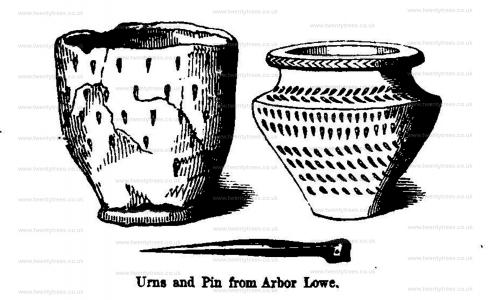
Wetton Near Hill. At page 83 of Vestiges, is a notice of an excavation made at one side of a barrow [Wetton Hill Barrow [Map]] on the summit of Wetton near Hill, when after having found one interment, we desisted through meeting with the natural rock in front of our cutting, Mr. Carrington thinking it probable that something might yet remain, made a cutting from the opposite side on the 23rd and 24th of May, having previously made trials in different parts of the mound, which showed that in some places the materials were large stones, and in others gravel, both favourable indications. After removing stones to the depth of about a yard, we found a skeleton accompanied by one rude flint arrow; it lay on the left side, with the knees drawn up, and was that of a strong man in full vigour. The skull, with the exception of the lefl side, which was decayed from contact with the earth, is perfect, and of a shape very unusual amongst Celtic crania, being remarkably short and elevated, like the Turkish skull. It is amongst the number selected for publication in the Crania Britannica, as an example of the acro-cephalie variety. Proceeding forward, we found another skeleton, the feet of which were very near the head of the first, deposited in the contracted posture in a cist, roughly made of large limestones, and partly covered with others of the same kind. Before the face was a very beautiful vase, 4½ inches high, with a fluted border and four perforated ears, wHch will be understood from the cut. A piece of flint and a tine of stags' horn lay close behind the skull, and a few more pieces of flint were found near. The skull, in perfect condition, is that of an old man, some of the teeth wanting, the alveoli being absorbed, the rest exceedingly worn; it is essentially square and massive in appearance, and is of the platy-cephalic variety. It is engraved and fully described in the Crania Britannica, where its internal capacity is stated to be 80 ounces. When cleaning it, on the day after its discovery, the cricoid cartilage, in a state of ossification, fell from the interior through the foramen magnum, where it had probably been conveyed by the rats which hibernated in the tumulus.
The femur measured 18 inches. The occurrence of two crania of the most opposite extremes of aberration from the ordinary Celtic type, in one tumulus, is most remarkable, and cannot fail to interest craniographers.
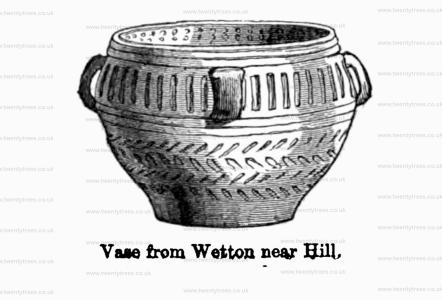
On 23 May 1849 Elizabeth Frances Egerton died. Memorial at All Saints Church, Old Rode.
Elizabeth Frances Egerton:
she was born to William Egerton.
On 24 Nov 1846 Lieutenant-General Richard Wilbraham and she were married. They were first cousins.
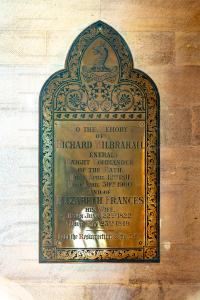
Monsal Dale. On the 23rd of May, we resumed our labour in two parties, digging at once on either side, between our former cutting and the north and south verge of the mound [Hay Top Barrow [Map]], and carrying on the trenches towards the west, where the barrow was most perfect, the whole of the eastern edge having been carted away. In the south cutting we found an oval cist about three feet from the surface, sunk a foot in rock and lined with a few flat stones; the diameter was under a yard, but it contained the skeleton of an aged man lying on his right side, with the knees necessarily so much drawn up as to approach the face, the head pointed to the south-west: and near it was a neat ornamented vase of imperfectly baked clay, 5½ inches high, and a perforated bone pin, about six inches long. On this side the tumulus was also found part of another skull, which had been removed from some other place.
While these discoveries were being made, the excavation on the north side was equally productive, for immediately below the grass were many fragmentary human bones, amongst which we found an iron spear, with the socket broken, yet 9½ inches long; and a blue glass bead, with a spiral thread of white running through it, which objects, we were informed, had been disturbed many years before, by a man digging in the mound under the impression of its being a mineral hillock: they must have belonged to a body interred near the surface at a late or Saxon age. Proceeding deeper, we found the rock cut away for a large space about two feet lower than its ordinary level, making the entire depth from the grass rather more than four feet. At the east extremity of this excavation there was a small enclosure of flat stones, something like that on the other side, before described, containing a skeleton much contracted, and in this case lying on its lefl side, with the head to the south, accompanied by one flint arrow point.
About the middle of the excavation, in the rock, were two rather small human crania, placed side by side, near a drinking-cup 7¼ inches high, ornamented with a lozengy pattern. Upon the crown of one of the skulls was a neatly chipped instrument of grey flint, and it is singular that no trace either of the lower jaws or of any other parts of the skeletons could be seen, though no dis-arrangement had ever taken place in this part of the mound, and it is certain that the crania alone had been buried there. At a little distance from them were the skeleton of a child, and one cylindrical jet bead. These discoveries, with the occurrence of numerous broken bones, both human and animal in the upper parts of the trenches, terminated the labours of the day. A portion of the west side of the mound intervening between the cuttings being reserved for the next day's examination, when it was cut out to the level of the rock, disclosing a grave about a yard square, sunk about three feet lower. Inside this excavation was a very neat rectangular cist, 2 feet long and 18 inches wide, formed of four flat slabs of limestone, filled with limestone, gravel, and rats' bones, which being very carefully removed, allowed us to see the skeleton of a child, doubled up, with the head to the south, and a most beautiful little vase, 4⅜ inches high, completely covered with a minute chevron pattern, lying obliquely in contact with the pelvis of the child, which had become thrust into it by the pressure of the grave; the depth at which this deposit lay was about five feet from the surface of the mound. The skeleton of the child is arranged in a glass case at Lomberdale House [Map], and from the abnormal shape of the head, it is probable that death was occasioned by hydrocephalus. Many burnt bones, and disjointed bones, as before, were found in the course of the day. The plan of this interesting barrow will illustrate the foregoing account.

On 23 May 1860 Dante Gabriel Rossetti (age 32) and Elizabeth Siddal (age 30) were married at St Clement's Church.
After 23 May 1924. Memorial to Major-General Vere Bonamy Fane (deceased) at St Nicholas' Church, Fulbeck.
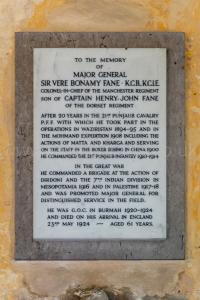
After 23 May 1925. Memorial to Edward Ticker Leeke at Lincoln Cathedral [Map].
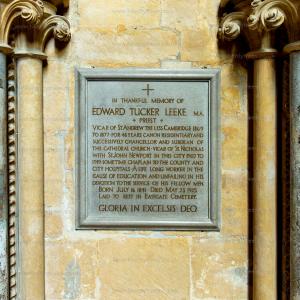
After 23 May 1927. Memorial to Edmond Yeo at the Church of the Holy Trinity, Weare Giffard.
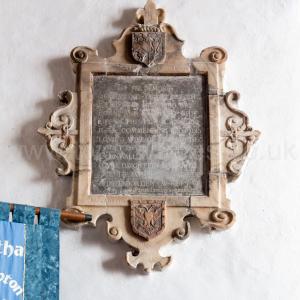
After 23 May 1927. Memorial to George Rodolph Trefusis at the Church of the Holy Trinity, Weare Giffard.
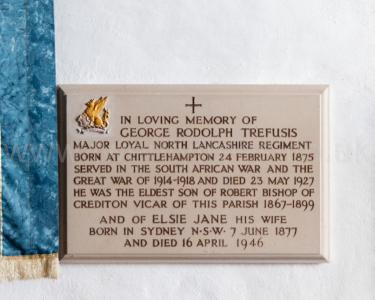
After 23 May 1966. Memorial to Cecil George Armitage Preston 1903-1966 Vicar of the Church of St Leonard, Apethorpe [Map].
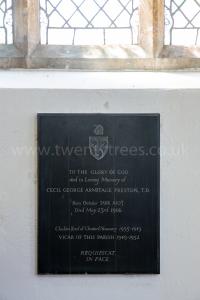
Births on the 23rd May
On 23 May 1052 Philip "Amorous" I King France was born to King Henry I of France (age 44) and Anne Rurik Queen Consort France (age 22).
On 23 May 1359 Robert Poyntz was born at Archenfield, Herefordshire.
On 23 May 1393 James "White Earl" Butler 4th Earl Ormonde was born to James Butler 3rd Earl Ormonde (age 34) and Anne Welles Countess Ormonde (age 33) at Kilkenny, County Kilkenny. He a great x 3 grandson of King Edward "Longshanks" I of England.

Before 23 May 1548 Russell Lee was born illegitimately to Anthony Lee (age 38) and Anne Hassall.
Before 23 May 1548 Richard Lee was born illegitimately to Anthony Lee (age 38) and Anne Hassall.
On or before 23 May 1562 Ellis Crispe was born to Thomas Crispe and Elizabeth Steward at Marshfield, Gloucestershire. He was baptised on 23 May 1562.
On 23 May 1616 Edward Bagot 2nd Baronet was born to Hervey Bagot 1st Baronet (age 25).
On 23 May 1617 Elias Ashmole was born in Breadmarket Street Lichfield, Staffordshire [Map].
On 23 May 1618 Brian Broughton 1st Baronet was born to Thomas Broughton and Frances Bagot (age 20).

On 23 May 1629 Wilhelm "The Just" VI Hesse-Kassel was born to Landgrave William V of Hesse-Kassel (age 27).
On 23 May 1674 James Scott was born to James Scott 1st Duke Monmouth 1st Duke Buccleuch (age 25) and Anne Scott Duchess Monmouth and Buccleuch (age 23). He a grandson of King Charles II of England Scotland and Ireland.

On 23 May 1707 Carl Linnaeus was born.
On 23 May 1723 James Aston 5th Baronet was born to Walter Aston 4th Baronet (age 63) and Anne Howard.
On 23 May 1730 Augustus Ferdinand Hohenzollern was born to Frederick William "Soldier King" I King Prussia (age 41) and Sophia Dorothea Hanover Queen Consort Prussia (age 43). He a grandson of King George I of Great Britain and Ireland. Coefficient of inbreeding 8.31%. 
After 23 May 1732 George Evans 3rd Baron Carbery was born to George Evans 2nd Baron Carbery (age 29) and Frances Fitzwilliam Baroness Carbery (age 22).
Around 23 May 1743 Margaret Gould was born.
On 23 May 1749 Christopher Sykes 2nd Baronet was born to Mark Sykes 1st Baronet (age 38) and Decima Woodham.
On 23 May 1752 Gore Townsend was born.
On 23 May 1755 Jane Fleming Countess Harrington was born to John Fleming 1st Baronet (age 25).
On 23 May 1755 Thomas Walpole was born to Thomas Walpole (age 27) and Elizabeth Vanneck (age 23).
On 23 May 1767 John Saunders Sebright 7th Baronet was born to John Saunders Sebright 6th Baronet (age 41).
On 23 May 1771 Amelius Beauclerk was born to Aubrey Beauclerk 5th Duke St Albans (age 30) and Catherine Ponsonby Duchess St Albans (age 28). He a great x 2 grandson of King Charles II of England Scotland and Ireland.

On 23 May 1772 Henry de la Poer Beresford 2nd Marquess Waterford was born to George de la Poer Beresford 1st Marquess Waterford (age 37) and Elizabeth Monck Marchioness Waterford (age 30).

On 23 May 1794 Edward Ayshford Sanford was born to William Sanford (age 22).
On 23 May 1797 Frederick Walpole Keppel was born to Frederick Keppel (age 34). He a great x 3 grandson of King Charles II of England Scotland and Ireland.
On 23 May 1803 Spencer Bulkeley Wynn 3rd Baron Newborough was born to Thomas Wynn 1st Baron Newborough (age 67) and Maria Stella Chiappini Baroness Newborough (age 30).
On 23 May 1805 George Stanhope 6th Earl Chesterfield was born to Philip Stanhope 5th Earl Chesterfield (age 49) and Henrietta Thynne (age 42).

On 23 May 1809 Captain George Augustus Frederick Heathcote was born to Robert Heathcote (age 32).
On 23 May 1810 William Molesworth 8th Baronet was born to Arscott Ourry Molesworth 7th Baronet (age 21) and Mary Brown Lady Molesworth.
On 23 May 1813 Thomas Whichcote 7th Baronet was born to Thomas Whichcote 6th Baronet (age 25) and Sophia Sherard Lady Whichcote (age 17).
On 23 May 1813 Almeria Hamond was born to Philip Hamond of High House in West Acre in Norfolk (age 31) and Anne Packe (age 36).
On or before 23 May 1849 Katharine Frances Wilbraham Lady Wilbraham was born to Lieutenant-General Richard Wilbraham (age 38) and Elizabeth Frances Egerton. Coefficient of inbreeding 7.04%. 
On 23 May 1849 Algernon Digby was born to Reverend Kenelm Henry Digby (age 42).
On 23 May 1854 Robert Mowbray Howard-Molyneux-Howard was born to Henry Howard-Molyneux-Howard (age 51).
On 23 May 1855 Robert Bourchier Sherard Wrey 11th Baronet was born to Henry Bourchier Toke Wrey 10th Baronet (age 25) and Marianne Sarah Sherard Lady Wrey (age 20).
On 23 May 1865 James Heron Walker 3rd Baronet was born to James Walker 2nd Baronet (age 35) and Louisa Susan Marlborough Heron-Maxwell (age 24).
On 23 May 1871 Thomas Temple was born to Joseph Temple.
On 23 May 1875 Annette Louise Monck Countess Liverpool was born to Henry Monck 5th Viscount Monck (age 26) and Edith Caroline Sophia Scott Viscountess Monck (age 19).

On 23 May 1890 Dagmar Glücksburg was born to Frederick VIII King Denmark (age 46) and Louise of Sweden Queen Consort Denmark (age 38).
On 23 May 1892 Albert Edward John Spencer 7th Earl Spencer was born to Charles Robert Spencer 6th Earl Spencer (age 34) and Margaret Baring Countess Spencer.
On 23 May 1893 Robert Godfrey Wolseley 5th Bewicke-Copley Baron Cromwell was born to Brigadier-General Alington Bewicke-Copley (age 38) and Selina Frances Watson-Copley (age 37).
On 23 May 1909 William Philip Sidney 1st Viscount de l'Isle was born to William Sidney 5th Baron De Lisle and Dudley (age 49). He a great x 2 grandson of King William IV of the United Kingdom.
On 23 May 1909 Rose Gwendolen Louisa McDonnell was born to Randall McDonnell 7th Earl of Antrim (age 30) and Margaret Isabel Talbot Countess of Antrim.
On 23 May 1918 Robert William Gerard 4th Baron Gerard was born to Frederick John Gerard 3rd Baron Gerard (age 34).
On 23 May 1919 Elizabeth Rosamund Peyton was born to Algernon Peyton 7th Baronet (age 30).
On 23 May 1921 Humphrey Lyttelton was born to George William Lyttelton (age 38) and Pamela Marie Adeane (age 32).
On 23 May 1926 John Chevallier Hoskyns 15th Baronet was born to Edwyn Clement Hoskyns 13th Baronet (age 41).
On 23 May 1948 Jennifer Michelle Souter was born to Richard Souter 25th Baron Audley (age 33).
On 23 May 1951 Henry Vivien Conyngham 8th Marquess Conyngham was born to Frederick William Conyngham 7th Marquess Conyngham (age 27).
Marriages on the 23rd May
On 23 May 1107 Louis "Fat" VI King France (age 25) and Lucienne Rochefort (age 19) were divorced.
23 May 1200 Louis "Lion" VIII King France (age 12) and Blanche Ivrea Queen Consort France (age 12) were married. She the daughter of Alfonso VIII King Castile (age 44) and Eleanor Plantagenet Queen Consort Castile (age 38). He the son of King Philip II of France (age 34) and Isabelle Flanders Queen Consort France. They were third cousins. He a great x 3 grandson of King William "Conqueror" I of England. She a granddaughter of King Henry "Curtmantle" II of England. 


On 23 May 1278 Theobald Metz II Duke Lorraine (age 15) and Isabelle Lady Rumigny Duchess Lorraine were married. She by marriage Duchess Lorraine. He the son of Frederick Metz III Duke Lorraine (age 38) and Margaret Blois Duchess Lorraine. He a great x 5 grandson of King William "Conqueror" I of England. 
After 23 May 1395 Thomas Neville Baron Furnivall (age 33) and Ankaret Strange 7th Baroness Strange Blackmere, Baroness Talbot (age 34) were married. They were second cousin once removed. He a great x 5 grandson of King Henry "Curtmantle" II of England. She a great x 5 granddaughter of King John "Lackland" of England. 

On 23 May 1548 Anthony Lee (age 38) and Anne Hassall were married.
On 23 May 1591 John Holles 1st Earl de Clare (age 27) and Anne Stanhope Countess de Clare (age 15) were married.
After 23 May 1612 John Mohun 1st Baron Mohun Okehampton (age 17) and Cordelia Stanhope Baroness Mohun Okehampton (age 27) were married.

Before 23 May 1618 Thomas Broughton and Frances Bagot (age 20) were married. The date of their marriage sometimes given as 26 Oct 1618 which is inconsistent with the date of birth of their son Brian Broughton 1st Baronet on 23 May 1618.

After 23 May 1685 Robert Kemp 3rd Baronet (age 17) and Letitia King were married.
On 23 May 1691 Thomas Spring 3rd Baronet (age 19) and Merelina Jermyn Lady Gage Lady Spring (age 18) were married. She by marriage Lady Spring of Pakenham in Suffolk.

On 23 May 1695 John Campbell 2nd Earl Breadalbaine and Holland (age 32) and Henrietta Villiers Countess Breadalbaine and Holland were married. He the son of John Campbell 1st Earl Breadalbaine and Holland (age 58) and Mary Rich.

On 23 May 1723 Arthur van Sittart (age 31) and Martha Stonhouse (age 25) were married.
After 23 May 1731 Charles Gregory and Elizabeth Morris were married. Her daughter Anne Chaplin also married a Gregory although the relationship with her husband in uncertain.
On 23 May 1732 George Evans 2nd Baron Carbery (age 29) and Frances Fitzwilliam Baroness Carbery (age 22) were married. He was given the Laxton Hall, Northamptonshire estate by his mother, worth £1100 per year, and an annuity on the family's Irish estates worth £1,400 per year.
On 23 May 1732 Charles Spencer 3rd Duke of Marlborough (age 25) and Elizabeth Trevor Duchess of Marlborough (age 19) were married. She by marriage Countess of Sunderland. He the son of Charles Spencer 3rd Earl of Sunderland and Anne Churchill Countess Sunderland.


Before 23 May 1733 Brook Bridges 2nd Baronet (age 25) and Ann Palmer (age 18) were married. Some sources refer to his marrying her sister Elizabeth Palmer (age 23) rather than her.
On 23 May 1751 Edward Astley 4th Baronet (age 21) and Rhoda Delaval (age 25) were married.
On 23 May 1753 Reverend John Stanley (age 60) and Sarah Earle (age 35) were married. The difference in their ages was 25 years.
On 23 May 1778 Charles Stanhope 3rd Earl of Harrington (age 25) and Jane Fleming Countess Harrington (age 23) were married at St Marylebone Church. He the son of William Stanhope 2nd Earl of Harrington (age 58) and Caroline Fitzroy Countess Harrington (age 56). He a great x 2 grandson of King Charles II of England Scotland and Ireland. 

Before 23 May 1779 Hugh Percy 2nd Duke Northumberland (age 36) and Anne Stuart (age 34) were divorced.

On 23 May 1779 Hugh Percy 2nd Duke Northumberland (age 36) and Frances Julia Burrell Duchess Northumberland (age 26) were married. He the son of Hugh Percy 1st Duke Northumberland (age 63) and Elizabeth Seymour Duchess Northumberland.

On 23 May 1797 Reverend William Clay and Sophia Raymond Lady Burrell (age 44) were married at St Marylebone Church.
On 23 May 1804 George Child-Villiers 5th Earl Jersey (age 30) and Sarah Sophia Fane Countess Jersey (age 19) were married at Berkeley Square, Mayfair. She the daughter of John Fane 10th Earl of Westmoreland (age 44) and Sarah Anne Child Countess of Westmoreland. He the son of George Bussy Villiers 4th Earl Jersey (age 68) and Frances Twysden (age 51).



On 23 May 1849 Charles Edward Petre (age 25) and Charlotte Elizabeth Petre (age 27) were married. They were first cousins. He a great x 5 grandson of King Charles II of England Scotland and Ireland. She a great x 5 granddaughter of King Charles II of England Scotland and Ireland.
On 23 May 1854 George Frederick D'Arcy Lambton 2nd Earl Durham (age 25) and Beatrix Frances Hamilton Countess Durham (age 19) were married at St George's Church, Hanover Square. She the daughter of James Hamilton 1st Duke of Abercorn (age 43) and Louisa Jane Russell Duchess Abercorn (age 41). He the son of John "Radical Jack" Lambton 1st Earl Durham and Louisa Elizabeth Grey Countess Durham. She a great x 4 granddaughter of King Charles II of England Scotland and Ireland. 

On 23 May 1860 Dante Gabriel Rossetti (age 32) and Elizabeth Siddal (age 30) were married at St Clement's Church.
On 23 May 1872 Hugh le Despencer Boscawen (age 23) and Mary Wentworth-Fitzwilliam were married. She the daughter of William Thomas Wentworth-Fitzwilliam 6th and 4th Earl Fitzwilliam (age 56) and Frances Harriet Douglas Countess Fitzwilliam.

On 23 May 1911 Hamar Greenwood 1st Viscount Greenwood (age 41) and Margery Spencer Viscountess Greenwood (age 24) were married.
Before 23 May 1921 George William Lyttelton (age 38) and Pamela Marie Adeane (age 32) were married.
On 23 May 1950 Edward John Chichester 11th Baronet (age 34) and Anne Rachel Pearl Douglas-Scott-Montagu (age 28) were married.

On 23 May 1972 Anthony Noel 6th Earl of Gainsborough (age 22) and Sarah Rose Winnington Countess Gainsborough (age 21) were married. He the son of Anthony Gerard Edward Noel 5th Earl of Gainsborough (age 48) and Mary Stourton Countess Gainsborough (age 46). He a great x 4 grandson of King William IV of the United Kingdom. 

Deaths on the 23rd May
Florence of Worcester Continuation. 23 May 1125. The emperor Henry (age 43) died, and was buried at Spires, where his grandfather was also interred. Lothaire, the ninety-eighth emperor of the Romans, reigned thirteen years.
On 23 May 1190 Walter Clifford 1st Baron Clifford (age 77) died at Godstow Abbey [Map] where he was subsequently buried. His son Walter Clifford 2nd Baron Clifford (age 30) succeeded 2nd Baron Clifford Feudal. Agnes Cundy Baroness Clifford by marriage Baroness Clifford Feudal.
Before 23 May 1326 Mary Ros Baroness de Braose (age 76) died.
On 23 May 1348 Piers Mauley 2nd Baron de Mauley (age 67) died at Mulgrave Castle. His son Piers Mauley 3rd Baron de Mauley (age 48) succeeded 3rd Baron Mauley. Margaret Clifford Baroness Mauley (age 41) by marriage Baroness Mauley.
On 23 May 1359 Otho Grandison (age 66) died.
On 23 May 1373 Nicholas II Longford (age 39) died at Longford [Map].
On 23 May 1395 Joan Furnival 5th Baroness Furnivall (age 20) died.
After 23 May 1441 Robert Constable (age 40) died at Beverley [Map].
On 23 May 1482 Mary York (age 14) died at Palace of Placentia, Greenwich [Map]. She was buried at St George's Chapel, Windsor Castle [Map].
On 23 May 1488 Robert Constable (age 65) died.
On 23 May 1497 James Pickering (age 77) died.
On 23 May 1520 Richard Carew (age 51) died at Beddington, Surrey.
On 23 May 1521 Thomas Stanley 2nd Earl of Derby (age 36) died. His son Edward Stanley 3rd Earl of Derby (age 12) succeeded 3rd Earl Derby, 11th Baron Strange Knockin, 7th Baron Mohun of Dunster, 4th Baron Stanley. Katherine Howard Countess Derby by marriage Countess Derby.

On 23 May 1541 Cuthbert Cunningham 3rd Earl Glencairn (age 64) died. His son William Cunningham 4th Earl Glencairn (age 48) succeeded 4th Earl Glencairn.
On 23 May 1542 Edward Musgrave of Hartley and Edenhall (age 81) died at Edenhall, Cumberland.
On 23 May 1566 Charles Habsburg Spain died.
On or before 23 May 1576 Francis Barnham died. He was buried at St Clements Church on 23 May 1576.
Before 23 May 1587 Henry Urquhart of Cromarty (age 23) died.
On 23 May 1594 Thomas Andrew of Winwick Manor (age 53) died at Winwick Manor, Northamptonshire.
On 23 May 1619 Stephen Soame (age 76) died. He was buried at St Peter's Church, Little Thurlow where he has an elaborate monument.
On 23 May 1623 Edward Lawley (age 37) died.
On 23 May 1631 Bishop John Buckeridge (age 69) died.
On 23 May 1663 Sophie Elisabeth Saxe Gotha died at Gotha.
On 23 May 1663 Henry Delves 2nd Baronet (age 65) died. His son Thomas Delves 3rd Baronet (age 32) succeeded 3rd Baronet Delves of Dodington in Cheshire.
On 23 May 1684 John Salusbury 4th Baronet (age 47) died. Baronet Salusbury of Lleweni in Denbighshire extinct. His sister Hester Salusbury (age 47) and her husband Robert Cotton 1st Baronet (age 49) inherited his estates.
On 23 May 1689 Charles Erskine 22nd Earl Mar (age 38) died. His son John Erskine 23rd Earl Mar (age 14) succeeded 23rd Earl Mar.
On 23 May 1698 Henry Cavendish (age 51) died.
On 23 May 1706 Louis Hesse-Kassel (age 19) died.
On 23 May 1716 Jane Paulet Countess Bridgewater (age 60) died.
On 23 May 1721 Essex Finch (age 34) died of smallpox.
On 23 May 1723 James Saunderson 1st Earl Castleton (age 56) died unmarried. Earl Castleton and Viscount Castleton extinct. His estates were inherited by his cousin Thomas Lumley-Saunderson 3rd Earl Scarborough (age 32) who added Saunderson to his surname.

On 23 May 1723 Anne Howard died.
On 23 May 1731 John Chaplin 2nd Baronet (age 20) died of smallpox. Baronet Chaplin of the Inner Temple in London extinct.
On 23 May 1733 Brook Bridges 2nd Baronet (age 25) died. His son Brook Bridges 3rd Baronet succeeded 3rd Baronet Bridges of Goodneston in Kent.
On 23 May 1734 Robert Pye 4th Baronet died. Baronet Pye of Hone in Derbyshire extinct.
On 23 May 1735 James Tobin Baronet (age 51) died.
On 23 May 1737 John Conduit (age 49) died.
On 23 May 1774 Mary Bertie died.
On 23 May 1790 George Brudenell aka Montagu 1st Duke Montagu (age 77) died. Duke Montagu extinct. His brother James Brudenell 5th Earl Cardigan (age 65) succeeded 5th Earl Cardigan. Elizabeth Waldegrave Countess Cardigan (age 31) by marriage Countess Cardigan. On His grandson Henry James Montagu Scott 2nd Baron Montagu (age 13) succeeded 2nd Baron Montagu of Boughton in Northamptonshire. Jane Margaret Douglas Baroness Montagu by marriage Baroness Montagu of Boughton in Northamptonshire.


On 23 May 1791 Gerard Vanneck 2nd Baronet (age 47) died unmarried. His brother Joshua Vanneck 1st Baron Huntingfield (age 45) succeeded 3rd Baronet Vanneck of Putney.
On 23 May 1797 Basil Fitzherbert (age 49) died.
On 23 May 1817 John Prendergast Smyth 1st Viscount Gort died unmarried. Charles Vereker 2nd Viscount Gort (age 49) succeeded 2nd Viscount Gort.
On 23 May 1828 Cecil Weld-Forester 1st Baron Forester (age 61) died of gout at Belgrave Square, Belgravia. His son John Weld-Forester 2nd Baron Forester (age 26) succeeded 2nd Baron Forester of Willey Park in Shropshire.
On 23 May 1829 John Stuart (age 51) died.
On 23 May 1830 Frances Anne Agar Viscountess Hawarden died without issue.
On 23 May 1836 Millicent Mary King (age 81) died.
On 23 May 1841 Louisa Norris (age 38) died.
On 23 May 1842 Edward St Lawrence died.
On 23 May 1843 Anne Margaret Coke Viscountess Anson (age 64) died.
On 23 May 1849 Elizabeth Frances Egerton died. Memorial at All Saints Church, Old Rode.
Elizabeth Frances Egerton:
she was born to William Egerton.
On 24 Nov 1846 Lieutenant-General Richard Wilbraham and she were married. They were first cousins.

On 23 May 1862 Augustus Frederick Guest (age 21) died.
On 23 May 1869 Eleanor Maitland (age 78) died.
On 23 May 1882 Elizabeth Henniker-Major Lady Henniker died.
On 23 May 1904 Mary Frances Nugent (age 93) died.
On 23 May 1918 Charles Rowley Drummond of Cromlix and Innerpefray (age 81) died.
On 23 May 1918 Gerard Henry Uctred Noel (age 73) died.
On 23 May 1924 Major-General Vere Bonamy Fane (age 60) died.
On 23 May 1935 Oswald Partington 2nd Baron Doverdale (age 63) died. His son Edward Partington 3rd Baron Doverdale (age 31) succeeded 3rd Baron Doverdale of Westwood Park in Worcestershire.
On 23 May 1939 Norah Ida Emily Noel (age 58) died.
On 23 May 1940 John Crichton 5th Earl Erne (age 32) died.
On 23 May 1946 Geoffrey Walter Harbord 9th Baron Suffield (age 84) died. His first cousin Richard Morden Harbord 10th Baron Suffield (age 80) succeeded 10th Baron Suffield, 11th Baronet Harbord of Suffield in Norfolk.
On 23 May 1947 Charles Hyde Villiers (age 84) died.
On 23 May 1960 Mary Heathcote-Willoughby-Drummond Countess Dalhousie (age 82) died.
On 23 May 1961 Alexandra Mary Cadogan Duchess of Marlborough (age 61) died.
On 23 May 1966 Hilda Brunner Viscountess Dillon (age 92) died.
On 23 May 1976 Captain Henry William Newman Fane (age 79) died.
On 23 May 1995 Geoffrey Waldegrave 12th Earl Waldegrave (age 89) died. His son James Waldegrave 13th Earl Waldegrave (age 54) succeeded 13th Earl Waldegrave, 14th Baron Waldegrave Chewton Somerset, 17th Baronet Waldegrave of Hever Castle.
On 23 May 1997 Peter Waldo Somerset Gough-Calthorpe 10th Baron Calthorpe (age 69) died. Baron Calthorpe of Calthorpe in Norfolk, Gough-Calthorpe of Edgbaston in Warwickshire extinct.
On 23 May 2006 James Lowther 7th Earl Londsdale (age 83) died. His son Hugh Lowther 8th Earl Lonsdale (age 56) succeeded 8th Earl Lonsdale, 9th Viscount Lowther, 9th Baron Lowther.
On 23 May 2020 John Eden 1st Baron Eden of Winton (age 94) died.